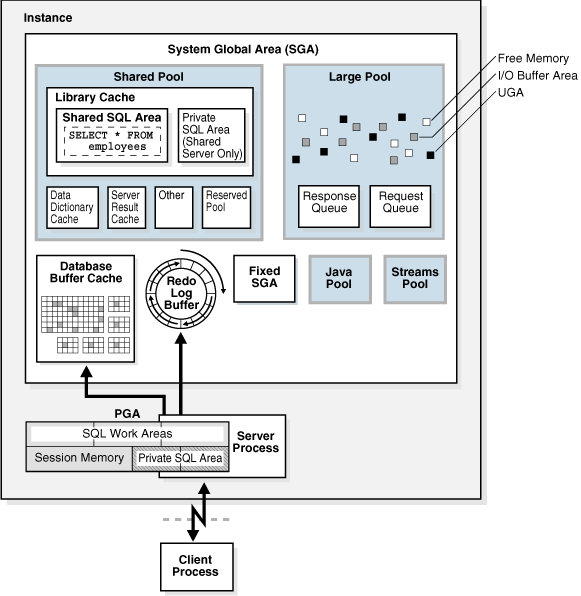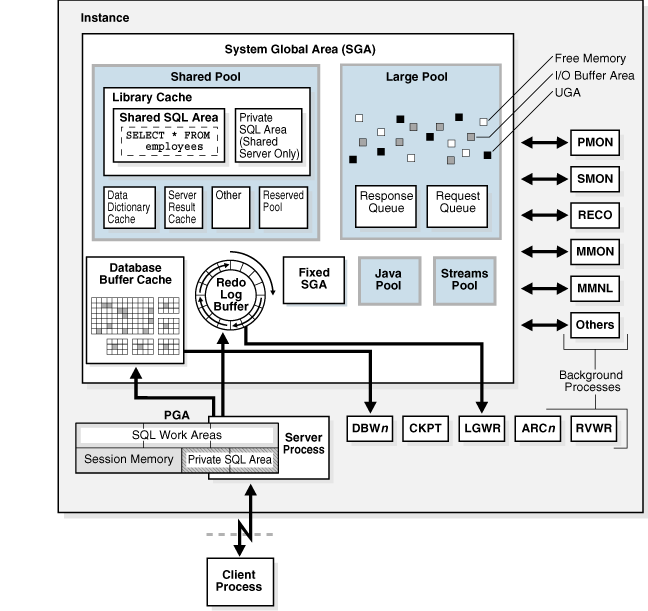Explain the Memory Structures
- System Global Area (SGA) - The SGA is a group of shared memory structures, known as SGA components, that contain data and control information for one Oracle Database instance. The SGA is shared by all server and background processes. Examples of data stored in the SGA include cached data blocks and shared SQL areas.
- Program Global Area (PGA) - A PGA is a nonshared memory region that contains data and control information exclusively for use by an Orcle process. The PGA is created by the Oracle Database when an Oracle process is started.
One PGA exists for each server process and background process. The collection of individual PGAs is the total instance PGA, or instance PGA. Database initialization parameters set the size of the instance PGA, not individual PGAs. - User Global Area (UGA) - The UGA is memory associated with a user session.
- Software Code Areas - Software code areas are portions of memory used to store code that is being run or can be run. Oracle Database code is stored in a software area that is typically at a different location from user programs-a more exclusive or protected location.

Describe the Process Structures
- Client processes run the application or Oracle tool code
- Oracle Processes run the Oracle Database code. Oracle processes include the following subtypes:
- Background Processes start with the database instance and perform maintenance tasks such as performing instance recovery, cleaning up processes, writing redo buffers to disk, and so on.
- Server Processes perform work based on a client request.
For example, these processes parse SQL queries, place them in the shared pool, create and execute a query plan for each query, and read buffers from the database buffer cache or from disk. - Slave Processes perform additional tasks for a background or server process.

Overview of Storage Structures
- Physical
- Data Files and Temp Files - A data file is a physical file on disk that was created by Oracle Database and contains data structures such as tables and indexes. A temp file is a data file that belongs to a temporary tablespace. The data is written to these files in an Oracle proprietary format that cannot by read by other programs.
- Control Files - is a root file that tracks the physical components of the database.
- Online Redo Log - is a set of file containing records of changes made to data.
- Logical
- Data Blocks - Oracle Database manages the logical storage space in the data files of a database in units called data blocks, also called logical blocks, Oracle blocks, or pages. An Oracle data block is the minimum unit of database I/O.
- Extents - is a logical unit of database storage space allocation made up of contiguous data blocks. Data blocks in an extent are logically contiguous but can be physically spread out on disk because of RAID striping and file system implementations.
- Segments - is a seg of extents that contains all the data for a logical storage structure within a tablespace. For example, Oracle Database allocates one or more extents to form the data segment for a table. The database also allocates one or more extents to form the index segment for a table.
- Tablespaces - is a logical storage container for segments. Segments are database objects, such as tables and indexes, that consume storage space. At the physical level, a tablespace stores data in one or more data files or temp files. A database must have the SYSTEM and SYSAUX tablespaces.

No comments:
Post a Comment